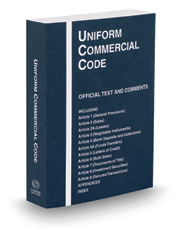

The UCC is a model code that covers the vast majority of contract law. It was created by a joint effort between the National Conference of Commissioners on Uniform State Laws and the American Law Institute. The UCC has no weight of law on its own. However, states can adopt sections of the UCC, in part or as a whole, making it statutory law for their jurisdiction. All fifty states have adopted portions of the UCC, with a majority of them making changes to the code so that it fits their needs.
The UCC is divided into eleven articles:
Article 1: General Provisions
Article 2: Sales
Article 2A: Leases
Article 3: Commercial Paper
Article 4: Bank Deposits and Collections
Article 4A: Funds Transfers
Article 5: Letters of Credit
Article 6: Bulk Transfers
Article 7: Warehouse Receipts, Bills of Lading and Other Documents of Title
Article 8: Investment Securities
Article 9: Secured Transactions; Sales of Accounts and Chattel Paper
Each article of the UCC either provides information about the UCC or covers a specific kind of contractt law. It is useful to know what article that you may be interested in so that you can narrow your research scope quickly.